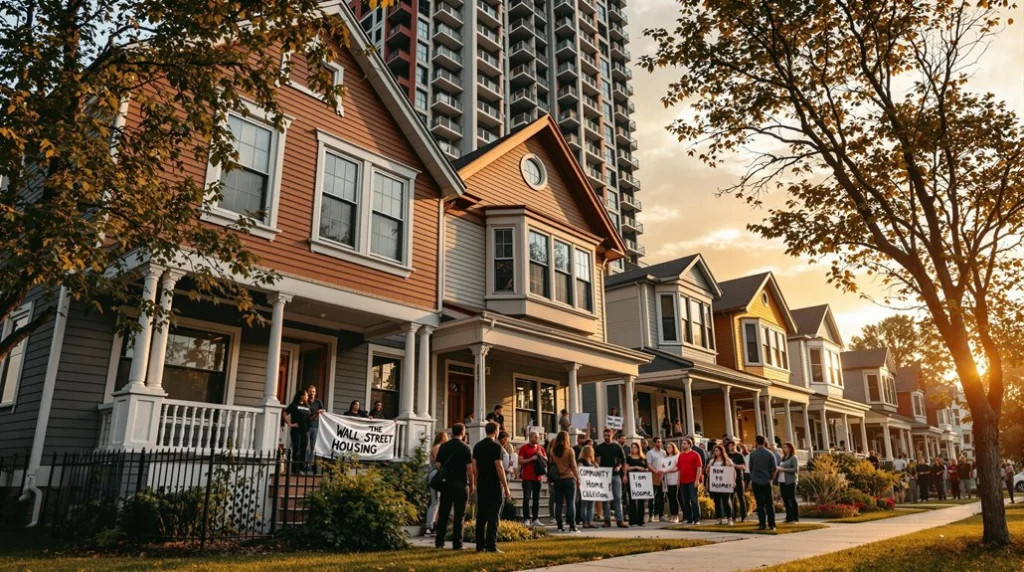Key Takeaways
- Co-living is becoming a popular housing option due to its affordability, flexibility, and built-in community, especially in high-cost cities.
- Traditional renting is on the decline as younger generations prioritize flexibility and shared experiences over long-term housing commitments.
- Co-living is reshaping the housing market, with more investors and developers embracing this model to meet the demands of urban populations.

Communal gathering spaces can be conducive to creating lasting friendships.
Rise of Co-Living: A New Way to Live, A New Way to Dream
Imagine waking up in a trendy urban loft, surrounded by like-minded people, but instead of living alone, you share your living space with a small community.
Welcome to the world of co-living—where the concept of traditional renting is steadily fading.
Co-living isn’t just a trend; it’s a response to the economic and social realities of today. High housing costs, the rise of remote work, and a desire for more connected lifestyles are driving this movement.
The “American Dream” used to be all about owning your own home or at least renting your own space. But that vision is being challenged as co-living spaces are popping up across major U.S. cities, offering affordability, flexibility, and a built-in community.
As more people turn to co-living to escape skyrocketing rent prices and isolation, the long-held ideals of privacy and homeownership are shifting.
It’s not just about where you live anymore—it’s about how you live and who you live with.
In this article, we’ll dive into why co-living is on the rise, how it threatens traditional renting, and what it means for the future of housing in America.
What is Co-Living?
Co-living is a modern twist on communal living, designed to meet the needs of today’s renters.
At its core, co-living offers shared spaces—like kitchens, living rooms, and work areas—while giving individuals their own private bedrooms or smaller personal spaces.
It’s a way to live more affordably while being part of a community.
In cities like New York, Los Angeles, and San Francisco, where rent prices are through the roof, co-living has become a smart option for many people, especially younger generations.
Instead of paying high rent for a small studio or a one-bedroom apartment, co-living allows residents to share the cost of a larger space while also benefiting from social interaction and a sense of community.
Historically, co-living isn’t a new idea. It’s evolved from older models like boarding houses and communes, but today’s version comes with modern amenities, better design, and a focus on lifestyle.
Co-living spaces often offer shared amenities like gyms, workspaces, and even regular social events, giving people a sense of belonging that traditional renting doesn’t always provide.
How Co-Living Works
Co-living spaces typically feature a range of communal areas, from kitchens to lounges, where residents can interact, share meals, or collaborate on projects.
Most co-living buildings also include private rooms or small apartments for personal downtime, giving people a balance between privacy and community life.
For many, the appeal is clear: lower rent, more flexibility, and the opportunity to live in a thriving community without the long-term commitment of traditional renting.
It’s all about adapting to modern needs, making co-living a unique alternative to the old housing model.
Rise of Co-Living in the United States
Co-living has taken off in the U.S., especially in urban centers where the cost of living has skyrocketed.
Several key factors are driving this surge, and it’s clear that co-living isn’t just a passing trend—it’s a response to the changing economic and social realities of modern life.
Economic Factors: The Cost of Living Crisis
One of the biggest reasons behind the rise of co-living is the simple fact that it’s getting harder and harder to afford rent in major cities.
In places like San Francisco, New York, and Los Angeles, rent prices have soared far beyond what the average person can comfortably afford. For many, the idea of renting a one-bedroom apartment is financially out of reach.
Co-living offers a more affordable option. By sharing common areas, residents can significantly reduce their living expenses while still enjoying the benefits of living in desirable, central locations.
Co-living companies often include utilities, internet, and even cleaning services in the rent, making it an attractive deal for those on a budget.
Social Shifts: Community Over Isolation
The way people think about community and social interaction has also shifted. Especially for younger generations, there’s a growing desire to be part of a community.
Co-living provides this in a way that traditional renting often doesn’t. Many co-living spaces organize social events, workshops, and even networking opportunities, allowing residents to build strong relationships with the people they live with.
Remote work and digital nomadism have also played a big role in this shift.
As more people work from home or travel for extended periods, co-living offers a flexible solution that can easily adapt to their needs.
Instead of signing a long-term lease, co-living spaces often allow for short-term stays, making it easier for residents to move around as they please.
Demographic Trends: Who’s Driving the Demand?
The demand for co-living is primarily driven by younger demographics—millennials and Gen Z. These groups tend to prioritize flexibility, affordability, and a strong sense of community.
Many of them are moving to urban centers for work opportunities, but they aren’t as interested in the long-term commitment of traditional renting or homeownership.
For these individuals, co-living offers a perfect blend of affordability and social engagement, without the strings attached to a typical lease.
It’s a housing model that fits with their lifestyle and financial realities.
Decline of Traditional Renting
As co-living continues to gain momentum, traditional renting is facing a significant decline.
High costs, rigid leases, and the overall lack of flexibility have made the traditional rental model less appealing, especially to younger generations who are looking for alternatives.
High Rental Costs
In major cities across the United States, the cost of renting a one-bedroom apartment has become unsustainable for many people.
The rent-to-income ratio is often skewed, with residents spending over 30% of their income on housing. In some cases, rent can easily take up half of a person’s monthly paycheck, leaving little room for savings or other expenses.
This rising cost has pushed people to seek more affordable living arrangements, which is where co-living steps in.
By splitting costs across shared spaces, co-living provides a more budget-friendly option without sacrificing the quality of life that urban dwellers crave.
Challenges with Traditional Renting
Traditional renting also comes with its own set of frustrations. From long-term leases that lock tenants into expensive contracts to large upfront costs like security deposits, renting has become a financial burden.
For many, the hassle of signing a lease and committing to a full year or more in one place no longer fits with their lifestyle or financial goals.
On top of that, traditional rentals don’t offer much flexibility. If you need to move for a job, change living situations, or even travel for a few months, breaking a lease can be costly and difficult.
Co-living, on the other hand, often offers month-to-month agreements or short-term options that give people the flexibility to adapt to life’s changes without being penalized.
Shifting Priorities
Today’s renters are prioritizing experiences and community over traditional measures of success like homeownership.
Younger generations, in particular, are placing more value on flexibility, shared experiences, and affordable living.
Owning a home, once considered the cornerstone of the “American Dream,” is no longer the top priority for many.
The focus has shifted from long-term stability to short-term fulfillment, and co-living fits this new mindset perfectly.
The traditional rental model, with its high costs and rigid structure, no longer caters to the evolving needs of modern renters.
Co-living is providing an alternative that’s more in tune with today’s lifestyles, making traditional renting less attractive for many. With flexible lease terms and a strong sense of community, co-living spaces cater to individuals seeking social interaction and shared experiences. For those curious about the dynamics and benefits of this innovative approach, coliving explained in detail can shed light on how it fosters collaboration and a supportive environment while reducing living costs.
Co-Living vs. The “American Dream”
The concept of the “American Dream” has long been tied to the idea of owning your own home, complete with a white picket fence, a steady job, and a sense of financial stability.
For decades, renting was seen as the stepping stone to homeownership—a temporary phase before reaching the ultimate goal of property ownership.
with the rise of co-living, that dream is being redefined.
Traditional American Dream: Homeownership and Privacy
For many, the traditional “American Dream” meant autonomy. Owning a home symbolized success, security, and stability. Renting was the interim, a way to live independently while saving for a down payment.
It also gave people the privacy they craved, with personal control over their living space and lifestyle.
However, in today’s economy, fewer people can afford to pursue that dream. With home prices rising faster than wages, owning property has become less attainable.
As a result, even traditional renting is becoming too expensive, forcing people to rethink their housing choices.
How Co-Living Challenges This Dream
Co-living flips this traditional concept on its head. Rather than focusing on ownership and individual privacy, co-living is all about shared spaces, flexibility, and affordability. It caters to a lifestyle that values community over privacy and experiences over material possessions.
For those embracing co-living, the dream isn’t about owning a home; it’s about living affordably, staying mobile, and building connections with like-minded individuals.
Co-living offers a way to live in desirable locations without the financial burden of homeownership or long-term rental commitments.
It also challenges the idea that owning property is the only way to achieve financial stability.
Cultural Implications: A New Way of Life
The rise of co-living also reflects broader cultural changes. Younger generations are more focused on experiences, travel, and personal fulfillment than on traditional markers of success like homeownership.
For many, co-living represents freedom—the freedom to move, to connect, and to live life on their terms.
But this shift raises an important question: Is the “American Dream” of homeownership fading, or is it simply evolving?
Co-living may not provide the same sense of permanence or personal space, but it offers a different kind of security—one rooted in community and flexibility.
Benefits of Co-Living
Co-living isn’t just a trendy housing option; it offers several practical benefits that are drawing in more and more people, especially younger generations.
From cost savings to a sense of community, here’s why co-living is reshaping how we think about housing.
Affordability: Living Smarter for Less
The most obvious benefit of co-living is affordability. In cities where rent prices are soaring, co-living offers a much cheaper alternative to renting a private apartment.
By sharing common spaces like kitchens and living rooms, residents can cut down on rent, utilities, and other housing expenses.
In most co-living spaces, rent often includes utilities, internet, and sometimes even amenities like cleaning services, which adds even more value.
For people trying to save money or get by on a tight budget, co-living can be a game-changer.
Community and Socialization: Combatting Loneliness
One of the biggest perks of co-living is the built-in sense of community.
Unlike traditional rentals where you may not even know your neighbors, co-living encourages social interaction.
Residents share communal spaces, and many co-living companies organize regular social events like dinners, game nights, or even professional networking meetups.
For people moving to a new city, co-living offers a way to quickly build connections and avoid feelings of isolation.
This sense of community is especially important in today’s world, where more people are working remotely and spending less time in traditional social settings like offices or schools.
Flexibility: Short-Term, No Strings Attached
Co-living is also attractive because of its flexibility. Unlike traditional rentals that require long-term leases, co-living spaces often offer short-term stays or month-to-month agreements.
This flexibility is perfect for those who need a temporary place to live, such as remote workers, freelancers, or people who move frequently for work or travel.
This adaptability allows people to live in high-demand locations without the stress of committing to a long-term lease, making co-living an ideal solution for the modern, mobile lifestyle.
Drawbacks of Co-Living
While co-living offers many advantages, it’s not without its downsides. Sharing spaces with others and the limitations of the co-living model can present challenges for some residents.
Here are some of the most common drawbacks.
Privacy Concerns: Sharing Isn’t Always Easy
One of the biggest issues with co-living is the lack of privacy. In a co-living arrangement, you’re sharing communal areas like kitchens, bathrooms, and living rooms with others.
For people who value their personal space or are used to living alone, this can be a tough adjustment.
Even though co-living spaces offer private bedrooms, the constant interaction with other residents can feel overwhelming, especially for introverted individuals.
You might have to deal with different personalities, noise levels, or messy housemates, which could disrupt the peace and comfort of home.
Stigma and Perception: Not for Everyone
For some, co-living can carry a stigma. It may be viewed as a step down from traditional renting or homeownership, resembling dormitory life or signaling financial instability.
Despite its growing popularity, some people see co-living as a temporary solution for young people rather than a long-term living arrangement.
This perception can be off-putting to those who seek more permanent housing or want the traditional independence of renting or owning their own space.
Co-living may not appeal to families, older adults, or those who prioritize having full control over their living environment.
Limited Availability: Mostly Urban Centers
Another drawback of co-living is its limited availability. Most co-living spaces are concentrated in major metropolitan areas like New York, San Francisco, or Los Angeles.
This means that if you’re living in a suburban or rural area, co-living options may be scarce or nonexistent.
The appeal of co-living is largely tied to high-cost urban markets where housing affordability is a major issue.
But for people outside these areas, traditional renting or homeownership may still be the primary option.
Massive Upside for Real Estate Investors: Why Co-Living is the Future for Landlords
For real estate investors, co-living isn’t just a trend—it’s a game-changer.
The traditional rental model, with long-term leases, high tenant turnover, and the constant challenge of filling vacancies, is looking a little tired these days.
Meanwhile, co-living is swooping in and solving problems for both tenants and property owners.
If you’re an investor or landlord, this new model could be your golden ticket to higher returns, more stable cash flow, and happier tenants.
Solving the Vacancy Problem: Higher Occupancy, Lower Turnover
Let’s face it: with traditional rentals, the dreaded vacancy is every landlord’s nightmare.
Whether it’s a few weeks between tenants or a few months, those empty units are nothing but dead weight on your balance sheet.
Co-living turns that on its head by significantly increasing occupancy rates.
How?
You’re maximizing the use of space. Instead of renting a 3-bedroom apartment to a family, you’re renting those rooms individually to three separate tenants, all of whom are paying for their slice of the space.
Co-living spaces typically boast much higher occupancy rates than traditional rentals because the cost per person is lower, making the rental units much more attractive to a broader market—especially young professionals, digital nomads, and those looking for affordable, flexible housing options.
Plus, the shared-living arrangement fosters a sense of community, which reduces turnover.
Tenants stay longer when they feel connected to the people they live with and are paying less overall. So, as an investor, you’re dealing with fewer vacancies and less turnover. That’s a win-win.
Increased ROI: Rent More Per Square Foot
One of the most exciting aspects of co-living for landlords is the increased return on investment (ROI).
Traditional renting locks you into one rate per unit, but co-living allows you to rent out multiple rooms individually. That’s more rental income per square foot.
The magic of co-living is that tenants are willing to pay slightly more for a room in a shared space because the overall cost is still much lower than renting a traditional apartment.
So, while you’re offering affordability to tenants, you’re also boosting your profits as a landlord.
This model works especially well in high-demand urban areas where rental prices are through the roof.
You get to turn one unit into multiple revenue streams, without having to increase your overhead costs significantly.
Flexibility and Efficiency: Fewer Lease Headaches
Let’s talk flexibility.
In the traditional rental model, long-term leases can be rigid, with tenants locked into 12-month contracts. That’s not ideal for people who need short-term solutions or who want to avoid the financial strain of a long-term commitment.
Co-living solves this for tenants by offering short-term, flexible leases—often month-to-month—making it highly attractive for digital nomads, freelancers, and young professionals.
For investors, this flexibility is an asset. You’re no longer chasing long-term tenants, and because co-living spaces are in such high demand, filling vacancies is a breeze.
And let’s not forget: co-living companies often handle the headaches of managing these shorter-term leases for you, ensuring smooth operations and tenant satisfaction.
Built-In Community: Solving Isolation and Building Retention
One of the biggest problems with traditional rentals is the isolation tenants often feel, particularly in big cities.
They might be paying top dollar to live alone in a one-bedroom apartment but feel disconnected from their neighbors and the community.
Co-living, on the other hand, is built on the idea of shared spaces and social connections.
This isn’t just good for tenants—it’s great for you, the landlord.
Why?
Because happy tenants stay longer. When residents feel like they’re part of a community, their satisfaction—and retention—skyrockets. Instead of juggling high turnover, you get to sit back and enjoy the benefits of longer, more stable tenancies.
As an investor, tenant retention is key to keeping your property profitable, and co-living’s community-focused environment makes that happen.
Modern Tenants Want More Than Just a Place to Live
Today’s renters—especially millennials and Gen Z—are looking for more than just four walls and a roof. They want experiences, connections, and flexibility.
Co-living provides all of that. Instead of renting a stale, lonely apartment, they get access to amenities like shared kitchens, workspaces, gyms, and even curated social events.
And they get to enjoy all of this without the steep price tag.
For investors, this shift in what tenants want presents a golden opportunity.
By catering to this new demand, you position yourself ahead of traditional landlords who are still stuck offering the same old renting options.
In an increasingly competitive market, co-living allows you to tap into a growing demographic of renters who value community, affordability, and lifestyle.
Co-Living is the Future of Rental Property
As an investor, ignoring the co-living trend would be like ignoring the internet in the ‘90s. It’s a disruptive model, and the upside is massive.
With higher occupancy rates, increased rent per square foot, and happier, long-term tenants, co-living addresses many of the challenges that have plagued traditional rentals for years. The market is moving, and those who adapt will reap the rewards.
Co-living is the future, and it’s here to stay.
If you’re a property owner or investor looking to maximize your returns, now is the time to explore co-living. It’s solving real problems for both tenants and landlords—and offering a level of flexibility, community, and profitability that traditional renting just can’t match.
Get ahead of the curve before everyone else catches on.
Future of Co-Living and Real Estate
Co-living is more than just a passing trend; it has the potential to reshape the future of real estate and how people think about housing in urban areas.
As this model continues to grow, it is driving innovation and change in the housing market.
Growth Projections: Expanding the Co-Living Market
The co-living market is projected to grow rapidly over the next decade, particularly in urban areas where housing shortages and high costs persist. Real estate developers and investors are increasingly viewing co-living as a profitable opportunity.
Companies like Roomrs, Common, Padsplit, and WeLive (from WeWork) now defunct are expanding their co-living offerings across major U.S. cities and even globally.
As cities continue to experience population growth and the cost of living rises, co-living is expected to meet the demand for affordable, flexible, and community-focused housing.
The model is not only attracting young professionals but also digital nomads, freelancers, and people looking for shorter-term housing solutions.
Investment Opportunities: A New Real Estate Frontier
Real estate investors are taking notice of the co-living boom. With rising demand for affordable housing, co-living spaces offer a new investment avenue, particularly in densely populated urban centers.
Investors are seeing strong returns as co-living spaces tend to have higher occupancy rates and lower turnover compared to traditional rentals.
Developers are also embracing co-living because it maximizes space efficiency.
By designing buildings that encourage shared living, they can house more tenants in the same amount of space, increasing rental income while still offering lower individual costs.
Impact on the Traditional Housing Market
The rise of co-living has the potential to disrupt the traditional rental and housing market.
As more people, especially younger generations, opt for co-living, traditional landlords may need to adapt to shifting preferences.
This could lead to a greater focus on creating more communal spaces within existing rental buildings or offering more flexible lease options.
In the long term, the growth of co-living could pressure traditional rental prices to stabilize or even decrease as more affordable, shared-living options become available.
Co-living is driving a cultural shift in how people view housing, and real estate will need to evolve to meet these new demands.
The New American Dream: Redefined by Co-Living
Co-living is more than just a solution to high rent and tight urban spaces; it’s a reflection of broader cultural and economic shifts.
As housing costs continue to rise, and as more people seek flexibility and community, co-living is filling a critical gap in the market.
It challenges the long-held belief that the “American Dream” is tied to homeownership or traditional renting. Instead, it offers a new way of living that prioritizes affordability, shared experiences, and social connection.
While co-living might not be for everyone, it’s clear that it’s reshaping the way we think about housing, especially for younger generations.
As the co-living movement grows, it could redefine what it means to live in cities and how people achieve stability and success.
The real question is: Will co-living become the new normal in urban housing, or is it simply a stepping stone to the next big housing trend?
Either way, it’s already having a profound impact on how we live, work, and connect with others.
If you’re curious about co-living or considering it as a housing option, now is the perfect time to explore what’s available in your city.
Take a look at some of the leading co-living providers or check out spaces in your area to see if this flexible, community-driven lifestyle could be the right fit for you.
Share your thoughts or experiences with co-living in the comments—let’s keep the conversation going!





















